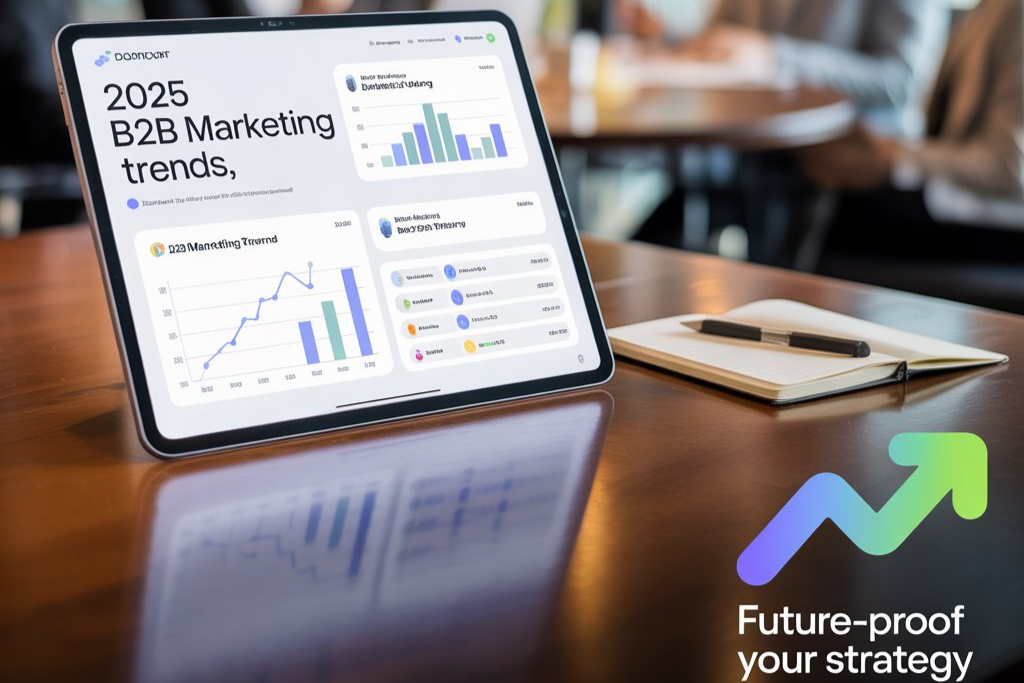Top B2B Marketing Trends to Boost Your Business in 2025

The landscape of B2B marketing is evolving rapidly, driven by technological advancements, shifting buyer behaviors, and the increasing demand for personalized experiences. As we move into 2025, understanding these changes is crucial for businesses looking to stay competitive. The digital transformation has redefined traditional marketing strategies, emphasizing data-driven decisions, automation, and customer-centric approaches.
Staying updated with the latest B2B Marketing Trends is not just an option but a necessity for businesses aiming to achieve sustainable growth. Companies that adapt to these trends can foster stronger relationships with their clients, optimize their marketing strategies, and ultimately drive higher revenue. In this blog, we’ll explore the key B2B Marketing Trends set to shape the industry in 2025, offering insights and strategies to help your business thrive in this dynamic environment.
The Evolution of B2B Marketing Trends in Recent Years
B2B marketing has undergone a remarkable transformation over the past few years, driven by technological advancements and shifts in consumer behavior. Companies have adapted to evolving market demands by embracing digital transformation, automation, and data-driven strategies.
Key B2B Marketing Trends from the Past 3-5 Years
- Digital-First Approach – With 87% of B2B buyers preferring digital interactions over traditional methods (McKinsey), businesses have prioritized online marketing, SEO, and content-driven engagement.
- AI & Automation – The rise of AI-powered chatbots, predictive analytics, and marketing automation tools has streamlined lead generation and improved customer experience.
- Personalization & ABM (Account-Based Marketing) – 80% of B2B buyers expect personalized experiences, pushing brands to focus on hyper-targeted messaging and customized content.
- Video Marketing Growth – Short-form videos, webinars, and interactive content have seen a 70% adoption increase, making visual storytelling a key engagement driver.
- Sustainability & Brand Ethics – B2B buyers increasingly prefer businesses that align with sustainability and ethical values, influencing brand positioning and marketing narratives.
Top B2B Marketing Trends to Watch in 2025
AI and Automation in B2B Marketing
Artificial Intelligence (AI) and automation are transforming B2B marketing trends, helping businesses enhance efficiency, improve personalization, and optimize lead generation. With 80% of B2B marketers already using AI-powered tools (Salesforce, 2023), the impact of automation is undeniable.
AI-Driven Analytics & Automation
AI enables real-time data analysis, predictive insights, and automated decision-making, allowing marketers to focus on strategy rather than manual tasks. According to McKinsey, companies that use AI-driven marketing see a 15-20% increase in ROI through improved targeting and efficiency.
Real-World Examples
- HubSpot uses AI-powered chatbots and automated email sequences to nurture leads and improve engagement.
- Adobe Sensei leverages AI to analyze customer data and personalize content dynamically, boosting conversions.
- Drift enhances lead qualification with AI chatbots, reducing response times and increasing conversions by 10x.
As B2B marketing trends continue evolving, businesses integrating AI and automation will stay ahead, delivering hyper-personalized experiences and maximizing efficiency.
The Rise of Account-Based Marketing (ABM) 2.0
B2B marketing trends are constantly evolving, and one of the most significant shifts is the emergence of Account-Based Marketing (ABM) 2.0. Unlike traditional ABM, which focused on a broad targeting approach, ABM 2.0 leverages data-driven personalization, AI-driven insights, and hyper-targeted engagement to build stronger relationships with key accounts.
How ABM Strategies Are Evolving
- AI and Predictive Analytics – Modern ABM integrates AI-powered tools to analyze buyer behavior and predict purchasing intent. 74% of marketers say AI enhances personalization in ABM strategies (Forrester).
- Multi-Channel Personalization – Businesses are using dynamic content, personalized email campaigns, and targeted LinkedIn ads to engage decision-makers at various touchpoints.
- Sales & Marketing Alignment – 91% of top-performing companies align sales and marketing efforts in ABM, ensuring a cohesive approach (TOPO Research).
- Intent Data Utilization – Advanced ABM platforms track real-time intent signals, allowing brands to tailor messaging at the perfect moment.
Case Studies: Successful ABM Campaigns
✅ Terminus & Snowflake: Snowflake, a cloud data company, leveraged ABM 2.0 with Terminus to create personalized ad campaigns for high-value accounts. The result? A 300% increase in deal size.
✅ Adobe’s ABM Success: Adobe combined AI-driven insights and a highly targeted content strategy to engage key B2B decision-makers. Their campaign led to a 50% boost in engagement rates and a 60% increase in sales pipeline.
As B2B marketing trends shift towards hyper-personalized engagement, ABM 2.0 is proving to be a game-changer. Businesses that embrace data-driven targeting, AI-powered insights, and cross-channel strategies will see higher conversion rates and deeper customer relationships in the evolving digital landscape.
Content Marketing with a Human Touch
As B2B marketing trends continue to evolve, businesses are moving away from generic sales pitches and embracing authentic, story-driven content that connects with their audience on a deeper level. In a world where 88% of B2B marketers use content marketing (CMI), the focus is shifting toward humanized storytelling, thought leadership, and value-driven engagement rather than product-heavy messaging.
The Shift Towards Authentic, Story-Driven Content
- Emotion Over Features – Buyers are overwhelmed with technical jargon. Instead, brands are using real customer stories, case studies, and testimonials to showcase impact. B2B content with a strong narrative increases engagement by 22% (Harvard Business Review).
- Conversational & Relatable Tone – Gone are the days of robotic corporate messaging. Brands like HubSpot and Salesforce use conversational language and relatable analogies to engage decision-makers.
- Video & Interactive Content – Short-form videos, live Q&As, and interactive storytelling tools are making B2B content more digestible and engaging. 73% of B2B buyers prefer video content over text when making purchasing decisions (Wyzowl).
Importance of Thought Leadership & Value-Based Content
✅ Positioning as an Authority – Companies investing in thought leadership drive 58% more engagement (Edelman). Whitepapers, in-depth blog posts, and expert interviews help establish credibility.
✅ Educate, Don’t Just Sell – Brands that provide actionable insights, industry reports, and trend analysis see better audience trust. For instance, LinkedIn’s B2B Institute regularly publishes research-backed reports that attract senior decision-makers.
✅ Value-Driven Approach – Instead of talking about products, companies like Slack focus on solving pain points through informative content, making them a go-to resource for B2B buyers.
As B2B marketing trends shift towards relationship-driven engagement, brands that prioritize authentic storytelling, valuable insights, and thought leadership will build stronger connections and long-term customer loyalty in an increasingly competitive market.
Video Marketing Dominance in B2B Campaigns
As B2B marketing trends continue to evolve, video content is taking center stage. What was once considered a tool for B2C brands has now become a game-changer for B2B marketing, with businesses leveraging short-form and live video to engage decision-makers. 81% of businesses use video as a marketing tool, with 70% of B2B buyers watching videos before making a purchase decision (Wyzowl).
Growing Impact of Short-Form & Live Video Content
- Short-Form Videos Drive Engagement – Platforms like LinkedIn, YouTube Shorts, and TikTok are reshaping B2B video strategies. Short videos under 60 seconds see 200% more engagement than longer formats (HubSpot).
- Live Video for Real-Time Connection – Webinars, live Q&As, and product demos offer direct interaction. Brands using live video see 10x more comments and 3x longer watch times (Livestream).
- B2B Decision-Makers Prefer Video – 59% of executives say they would rather watch a video than read text when researching a product (Forbes).
Best Practices for Creating Engaging B2B Video Content
✅ Hook Viewers in the First 5 Seconds – Attention spans are shrinking. Open with a strong statistic, question, or compelling statement.
✅ Keep It Educational & Value-Driven – 70% of B2B buyers say educational content makes them more likely to purchase from a brand (CMI). Use explainer videos, customer testimonials, and industry insights.
✅ Optimize for Mobile & Social Media – 90% of B2B buyers watch videos on mobile (Google). Add captions, use vertical formats, and keep videos platform-specific.
As B2B marketing trends lean heavily toward video-first strategies, businesses that prioritize short, engaging, and interactive video content will see higher engagement, better lead conversion, and stronger brand trust in the digital marketplace.
Data Privacy and Ethical Marketing
As B2B marketing trends evolve, one of the most pressing issues is the growing emphasis on data privacy and ethical marketing. With the implementation of strict data protection laws such as GDPR (General Data Protection Regulation) and CCPA (California Consumer Privacy Act), businesses are under increasing pressure to adopt transparent and secure data handling practices. This shift is not only legal but also essential in maintaining trust with consumers.
The Influence of Data Protection Laws on B2B Marketing Strategies
- Regulatory Compliance – 70% of businesses say that GDPR compliance has impacted their marketing strategies (Deloitte). B2B companies must now ensure that data collection, processing, and storage adhere to strict legal standards.
- Revised Data Collection Methods – Companies are using more opt-in models and explicit consent forms to ensure compliance. 78% of consumers say they are more likely to engage with a business that follows GDPR guidelines (PwC).
- Penalties for Non-Compliance – Failure to comply with these data protection laws can lead to heavy fines. For instance, Google was fined €50 million for non-compliance with GDPR, showcasing the importance of following these regulations.
Building Trust Through Transparent Data Practices
✅ Clear Communication – Businesses can build trust by being transparent about what data is being collected and how it will be used. 89% of consumers prefer to engage with businesses that clearly explain their data practices (Cisco).
✅ Security & Consent – Offering customers the ability to manage consent and reviewing how their data is stored builds long-term relationships. Companies like Mailchimp are leading by example by providing easy-to-navigate consent management tools.
✅ Ethical Marketing – 87% of consumers say they will not support brands that fail to act ethically with their data (Salesforce). B2B brands that use data for personalized marketing but also respect privacy rights are seen as more trustworthy and credible.
As B2B marketing trends shift towards ethical and transparent data practices, businesses that focus on clear communication, strong compliance, and building trust with their customers will stand out in an increasingly privacy-conscious market.
Voice Search and Conversational Marketing
As B2B marketing trends evolve, voice search and conversational marketing are becoming increasingly essential components of modern SEO and customer engagement strategies. With the rise of smart speakers and voice assistants, B2B companies must adapt their marketing efforts to optimize for voice search and leverage chatbots and conversational AI to enhance lead nurturing.
The Growing Role of Voice Search in B2B SEO Strategies
- Voice Search Growth – 55% of B2B buyers use voice search when researching products or services (Google). This growing trend has prompted marketers to rethink their SEO strategies to ensure they are visible in voice searches.
- Natural Language Processing (NLP) – Voice search users typically ask questions in a more conversational tone. 47% of B2B marketers are now optimizing content for question-based queries to appear in voice search results (HubSpot).
- Featured Snippets and Local SEO – Voice search often pulls data from featured snippets. Ensuring your content is structured for these snippets increases the chances of appearing in voice search responses, driving more organic traffic.
- Mobile Optimization – 40% of B2B voice searches occur on mobile devices, highlighting the importance of mobile-friendly websites and content (Google).
Utilizing Chatbots and Conversational AI for Lead Nurturing
✅ 24/7 Engagement – Chatbots powered by AI can provide instant responses, qualifying leads at any hour. Companies like Drift and Intercom have seen up to 50% faster lead conversion rates with the use of chatbots.
✅ Personalized Conversations – Conversational AI uses data from previous interactions to customize conversations, making them more relevant and engaging. 85% of B2B companies using chatbots report improved customer experiences (Salesforce).
✅ Lead Nurturing & Qualification – Chatbots can guide leads through the sales funnel by answering questions, scheduling demos, or offering product information, ensuring that sales teams focus only on the most qualified leads.
As B2B marketing trends embrace voice search optimization and conversational AI, businesses that integrate these technologies will see improved SEO rankings, more qualified leads, and stronger customer relationships.
Influencer Marketing in the B2B Space
As B2B marketing trends continue to evolve, influencer marketing is making its mark in the B2B sector. Unlike traditional B2C influencer collaborations, B2B influencer marketing leverages industry experts and niche influencers to build trust and expand brand reach. The rise of micro-influencers and industry-specific influencers has reshaped the landscape, making it possible for businesses to engage with highly-targeted audiences.
The Rise of Micro and Industry-Specific Influencers
- Micro-Influencers Dominate – While large-scale influencers are still valuable, 80% of marketers report that micro-influencers (those with fewer than 100k followers) offer better engagement rates and authenticity (Influencer Marketing Hub).
- Industry-Specific Impact – Industry experts who have a strong reputation within a niche market are increasingly seen as valuable assets. For example, B2B companies like HubSpot partner with industry thought leaders in marketing automation and CRM to amplify their message.
- Trust and Authenticity – 61% of B2B buyers say that they trust recommendations from industry influencers over traditional advertising (LinkedIn). These influencers play a critical role in providing genuine insights, which resonates with decision-makers looking for reliable sources.
Strategies to Collaborate Effectively with B2B Influencers
✅ Target the Right Influencers – The key to success in B2B influencer marketing is finding influencers with a genuine following in your industry. Look for alignment in values, goals, and audience interests. For example, SAP works with leading figures in enterprise software to ensure a perfect fit with their target market.
✅ Create Long-Term Partnerships – 58% of B2B marketers believe long-term relationships with influencers result in more successful campaigns (Edelman). By fostering consistent partnerships, you can create authentic narratives that resonate with your audience.
✅ Collaborate on Value-Based Content – Instead of just promoting products, collaborate with influencers to create value-driven content, such as whitepapers, case studies, and webinars, to engage with leads in a meaningful way.
✅ Measure ROI with Clear KPIs – Track the effectiveness of influencer partnerships by setting clear KPIs, such as engagement rates, lead generation, and brand awareness.
As B2B marketing trends shift towards influencer collaborations, businesses that engage with micro and industry-specific influencers will experience greater authenticity, better engagement, and stronger connections with their target audience.
Sustainable and Purpose-Driven Marketing
As B2B marketing trends evolve, sustainability and purpose-driven marketing have become key focal points. Companies are increasingly recognizing that both consumers and businesses are more likely to engage with brands that are committed to social responsibility and environmental sustainability. In fact, 61% of B2B buyers are more likely to choose brands with clear sustainability initiatives (McKinsey).
Why Sustainability Messaging is Becoming Crucial in B2B Marketing
- Increasing Demand for Ethical Practices – As environmental concerns rise, businesses are expected to reduce their carbon footprints and adopt sustainable practices. 73% of millennial B2B buyers prefer to work with companies that prioritize sustainability (Unilever).
- Regulatory Pressure – Governments worldwide are tightening regulations on emissions, waste, and resource usage, making sustainability an essential component of business strategy. Compliance with these regulations often requires companies to communicate their sustainable initiatives clearly.
- The ROI of Sustainability – Brands that incorporate sustainability into their business model can achieve higher revenue growth. Businesses with a strong sustainability focus see a 20% higher return on investment (ROI) than their counterparts (Harvard Business Review).
Brands Leading the Way with Purpose-Driven Campaigns
✅ Patagonia – While not traditionally B2B, their messaging on environmental activism sets a powerful example. They actively promote environmental causes through sustainability campaigns and partnerships with businesses that share similar values.
✅ Unilever – Unilever has been a leader in purpose-driven marketing within the B2B space, creating campaigns around sustainable agriculture and environmental stewardship. Their Sustainable Living Plan is widely recognized for its positive impact on their brand image.
✅ Salesforce – With initiatives such as their “1-1-1 model” (1% equity, 1% product, 1% employee time), Salesforce has incorporated corporate social responsibility into its culture, directly appealing to companies that prioritize social and environmental impact.
As B2B marketing trends shift towards sustainability and purpose-driven campaigns, brands that integrate these values into their core messaging will not only build stronger customer relationships but also create lasting impact in a world that increasingly values ethical business practices.
How to Adapt Your Strategy to Emerging B2B Marketing Trends
As B2B marketing trends continue to evolve, it is crucial for businesses to adapt their marketing strategies to stay ahead of the curve. Incorporating new trends into existing strategies requires both agility and a commitment to continuous learning. Here are practical tips for integrating emerging B2B marketing trends effectively.
Practical Tips for Integrating New Trends into Existing Marketing Strategies
- Evaluate and Adapt Existing Campaigns – Regularly review your current marketing campaigns to identify which elements can be enhanced by emerging B2B marketing trends. For example, if video content is becoming more popular, consider adapting your email marketing to include short video clips, webinars, or interactive elements.
- Leverage Data-Driven Insights – As B2B marketing trends increasingly rely on data and analytics, incorporating tools like AI and big data can offer valuable insights into your target audience’s behavior. Use these insights to refine your strategies and personalize campaigns. For example, businesses that use data-driven personalization report a 20% increase in conversion rates (McKinsey).
- Integrate New Technologies Seamlessly – Tools like AI chatbots, voice search optimization, and automated marketing platforms can be easily incorporated into your existing strategy. Start small with pilot programs to test their effectiveness before fully committing. This will help you manage resources efficiently and avoid unnecessary risks.
- Collaborate with Influencers – As influencer marketing grows in the B2B sector, begin building relationships with industry-specific influencers to expand your reach. Incorporating micro-influencers into your campaigns can also help you tap into niche markets.
Importance of Agility and Continuous Learning in B2B Marketing
- Stay Ahead of Competitors – Agility in B2B marketing means being able to quickly adapt to new technologies, changing customer preferences, and evolving trends. Companies that stay agile can pivot their marketing tactics faster than competitors, gaining a competitive edge.
- Foster a Culture of Learning – To succeed with emerging B2B marketing trends, businesses must prioritize continuous learning. This includes training teams on the latest tools, strategies, and platforms. Encourage regular upskilling and attend industry conferences or webinars to stay informed on the latest trends and innovations.
- Test and Iterate – Agility also involves testing new ideas and strategies to see what works best for your business. Implement A/B testing and measure results to improve your campaigns over time.
As B2B marketing trends evolve, companies that embrace agility and continuous learning, while integrating emerging trends into their existing strategies, will experience improved efficiency, higher engagement, and stronger relationships with their target audience.
Common Mistakes to Avoid When Following B2B Marketing Trends
As B2B marketing trends evolve, it’s easy to get caught up in the excitement of new technologies and tactics. However, making certain mistakes can undermine your strategy and limit the effectiveness of your efforts. Here are some common mistakes to avoid when adapting to emerging B2B marketing trends:
Over-Reliance on Automation Without Personalization
- The Automation Trap – While automation can significantly streamline processes and save time, over-relying on it without personalization can lead to disengaged customers. Studies show that 72% of customers prefer personalized marketing messages (SmarterHQ), and failing to tailor your automated content can result in missed opportunities for deeper engagement.
- Lack of Human Touch – As B2B marketing trends move toward personalized, relationship-driven strategies, it’s important to balance automation with meaningful human interactions. For instance, chatbots may be efficient for answering FAQs, but personalized email outreach or direct conversations with prospects can help build stronger, long-lasting relationships.
- Missed Customer Connections – Automated messages often come across as impersonal, leading to lower conversion rates. Instead, segment your audience and use automation to send targeted, relevant content that feels personalized for each group, which can significantly increase customer loyalty.
Ignoring Data Insights or Failing to Measure Campaign Effectiveness
- Not Leveraging Data – Data is a driving force behind many B2B marketing trends today. Ignoring insights from your analytics can result in missed opportunities. In fact, 70% of marketers agree that leveraging customer data improves marketing performance (Econsultancy). By neglecting data, you’re potentially leaving valuable insights untapped.
- Lack of Proper Measurement – It’s essential to track and measure the effectiveness of your campaigns. Without clear KPIs and data-driven insights, you cannot understand what’s working and what needs improvement. Failing to measure effectiveness can lead to wasted resources on underperforming tactics.
- Not Iterating Based on Insights – The key to success in B2B marketing trends lies in testing, learning, and iterating. By continuously measuring and adapting based on performance data, you can fine-tune your strategies to improve engagement, conversions, and ROI.
Avoiding these common mistakes when adapting to B2B marketing trends can help you build more effective, data-driven, and personalized campaigns, ultimately leading to stronger connections with your audience and better business outcomes.
Future Outlook: What’s Next Beyond 2025 for B2B Marketing Trends
As B2B marketing trends continue to evolve rapidly, it’s crucial to look ahead to what the future holds. Beyond 2025, the marketing landscape is expected to be shaped by emerging technologies and innovative strategies that will transform how businesses engage with their audiences. Here are some key predictions for the future of B2B marketing trends and tips on how to prepare your business for long-term success.
Predictions on Emerging Technologies and Strategies Beyond 2025

- AI and Automation – By 2025, AI will dominate B2B marketing strategies, enhancing personalization at an unprecedented level. Experts predict that AI-driven tools will enable businesses to create real-time, hyper-personalized experiences for their audiences. In fact, 61% of B2B marketers are already using AI for content creation, lead generation, and customer insights (Gartner). Going forward, predictive analytics and machine learning will help marketers better understand customer behavior and forecast trends before they emerge.
- Extended Reality (XR) – Technologies like augmented reality (AR) and virtual reality (VR) are expected to grow significantly in the B2B marketing space. These immersive technologies will enable businesses to offer virtual product demonstrations or 360-degree experiences to customers, helping them make more informed decisions. Companies like IKEA are already using AR to showcase how products will look in customers’ homes, and B2B marketers are expected to adopt similar approaches for trade shows, conferences, and online product showcases.
- Voice and Conversational AI – The integration of voice search and conversational AI is predicted to increase dramatically. By 2026, over 50% of all searches will be voice-based (Statista), and businesses will need to optimize their content for voice search. Additionally, AI chatbots will become even more sophisticated, enabling real-time, contextually relevant interactions with customers, improving customer support, and lead nurturing.
- Sustainability and Purpose-Driven Marketing – As sustainability becomes even more critical, B2B companies will need to integrate environmental and social governance (ESG) strategies into their marketing. By 2027, 72% of B2B buyers will make purchasing decisions based on a company’s commitment to sustainability (Forbes). Purpose-driven campaigns will play a pivotal role, as buyers increasingly demand transparency and ethical practices.
Preparing Your Business for Long-Term B2B Marketing Success
- Embrace a Data-Driven Culture – In the coming years, data will continue to be at the core of B2B marketing trends. Businesses should prioritize data-driven decision-making by investing in advanced analytics tools and platforms. This will enable them to gain actionable insights into customer preferences, campaign effectiveness, and industry shifts.
- Build Agility into Your Marketing Strategy – The key to thriving in the future of B2B marketing trends lies in maintaining agility. As technology evolves rapidly, businesses must be able to quickly adapt their strategies to new trends. Regularly update your marketing tactics and tools to ensure they remain relevant and effective.
- Focus on Personalization and Customer Experience – As B2B marketing trends move toward greater personalization, businesses will need to leverage advanced CRM systems and AI tools to create seamless, individualized customer journeys. Personalizing the experience at every touchpoint will help build stronger relationships and increase brand loyalty.
- Invest in Long-Term Relationships – Moving beyond just lead generation, the future of B2B marketing will focus on nurturing long-term relationships. Companies will increasingly invest in account-based marketing (ABM) and customer retention strategies to drive ongoing success. A focus on personalized customer care, post-purchase support, and loyalty programs will be essential for sustainable growth.
By staying ahead of B2B marketing trends and preparing for emerging technologies and strategies, businesses can position themselves for long-term success. Embracing innovation, focusing on sustainability, and enhancing personalization will ensure your company remains competitive and continues to thrive in an increasingly dynamic digital landscape.
Conclusion
B2B marketing trends are rapidly evolving and reshaping the landscape of business marketing. From the rise of account-based marketing and data-driven personalization to the growing dominance of video marketing and sustainability-driven strategies, it’s clear that staying updated on these trends is essential for long-term success. Digital Marketing Marvel is at the forefront of these innovations, empowering businesses to adapt, engage, and drive meaningful results in an ever-changing market.
Key takeaways from the B2B marketing trends discussed include:
- The integration of AI and automation for more personalized, data-driven strategies.
- The increasing reliance on video content and immersive technologies like AR and VR.
- The importance of purpose-driven marketing and sustainability in gaining trust and loyalty.
- The growing significance of voice search and conversational AI in enhancing customer engagement.
To stay competitive in 2025 and beyond, it’s essential to innovate, experiment, and adapt to the ever-changing landscape of B2B marketing trends. By embracing new technologies, leveraging data, and building personalized, ethical marketing strategies, you’ll be able to lead your business towards sustainable growth.
We encourage you to stay ahead of the curve and continually evolve your approach. Share your thoughts and experiences with new B2B marketing trends in the comments below – we’d love to hear how you’re adapting to these changes and the impact they’ve had on your business.


